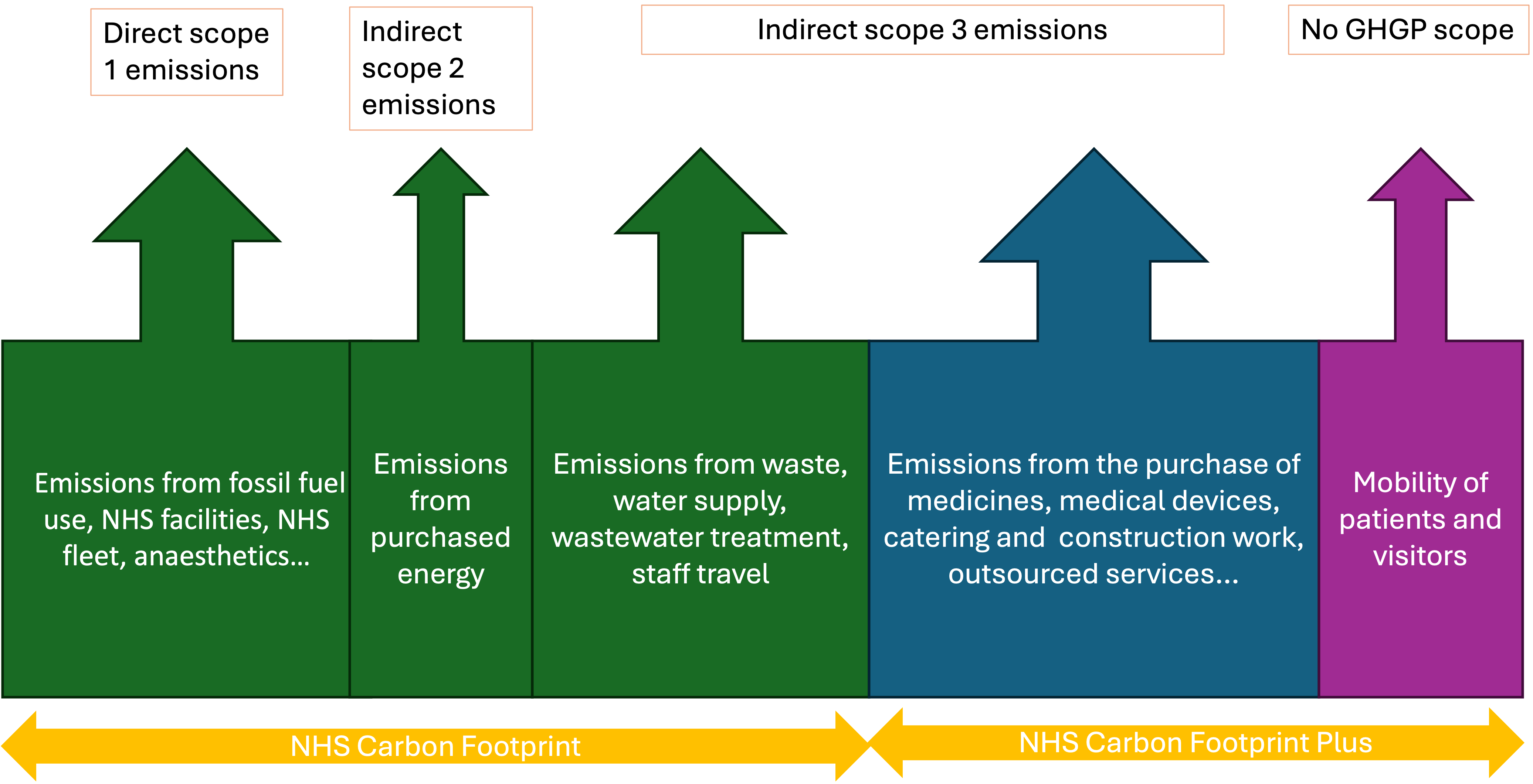Greener NHS
National Health Service working towards climate neutrality
The National Health Service (NHS) in the United Kingdom and Northern Ireland is taking steps to become more environmentally sustainable. The NHS has committed to the ambitious goal of achieving net zero carbon emissions by 2040, aiming to significantly reduce its climate impact in the coming years.
According to the 2019 ‘Health Care Climate Footprint Report’, the healthcare sector accounts for 4.4 percent of global net carbon emissions, with the USA, China and the European Union contributing 56 percent of that total.1) In response to this, the UK's National Health Service (NHS) launched the ‘For a Greener NHS’ campaign in January 2020. Dr. Matthew Tulley, Head of the Imperial College Healthcare NHS Trust's redevelopment programme, explains the motivation behind this initiative: “For nearly two decades, if not longer, it has been clear that climate change poses a significant threat to health, with impacts from flooding, extreme heat, drought and severe weather events. A few summers ago, London experienced an intense heatwave that resulted in thousands of additional deaths, and something similar occurred in Paris. The effects of climate change are becoming increasingly tangible. As a national health service, the NHS began to fully grasp the substantial impact it would face from these changes.”
Clear targets
The campaign aims to make the NHS the first health service in the world to achieve climate neutrality. This ambitious goal is set to be accomplished in two phases:
- By 2040, the NHS aims to reduce its direct and indirect carbon emissions (NHS Carbon Footprint) to net zero. As part of this plan, an interim target has been set to achieve an 80 percent reduction in emissions between 2028 and 2032. Direct emissions stem from fossil fuel use, NHS facilities such as hospitals, anaesthetics and transportation, including ambulances (scope 1 emissions). Indirect emissions include the release of greenhouse gases from electricity generation (scope 2 emissions), while scope 3 emissions cover activities such as waste production, energy supply for vehicles (well-to-tank), business travel, aerosol use (sprays) and water supply.
- By 2045, the NHS aims to achieve climate neutrality for emissions it can influence but does not directly produce (NHS Carbon Footprint Plus). An interim goal of an 80 percent reduction has been set for the period between 2036 and 2039. This category includes emissions from the production of medicines and medical supplies, hospital construction and hospital catering services.
To achieve its targets, the NHS uses a net zero modelling and analysis approach. This method is grounded in the NHS's estimated environmental footprint from 1990, combining top-down modelling (e.g. based on financial activity data) with bottom-up validation for categories that can be physically measured and quantified (e.g. energy consumption and waste).2)
 GHGP scopes in the context of the NHS: The Greenhouse Gas Protocol covers the greenhouse gases regulated under the Kyoto Protocol, including carbon dioxide, methane and nitrogen dioxide. The GHGP is divided into different scopes. Scope 1 includes the direct greenhouse gas emissions of a company, scope 2 the indirect emissions of a company and scope 3 the indirect emissions of cross-value-chain processes.
© Dr. Ariane Pott, according to ‘Delivering a ‘Net Zero’ National Health Service
GHGP scopes in the context of the NHS: The Greenhouse Gas Protocol covers the greenhouse gases regulated under the Kyoto Protocol, including carbon dioxide, methane and nitrogen dioxide. The GHGP is divided into different scopes. Scope 1 includes the direct greenhouse gas emissions of a company, scope 2 the indirect emissions of a company and scope 3 the indirect emissions of cross-value-chain processes.
© Dr. Ariane Pott, according to ‘Delivering a ‘Net Zero’ National Health Service
Investment is important for implementation
These targets were formalised on 1 July 2022 through the Health and Care Act 2022. The ‘Delivering a ‘Net Zero’ National Health Service’ report2) outlines the measures the NHS has already implemented or plans to introduce in order to reduce emissions. However, targets are not the only thing, as Dr. Tulley explains: “In addressing carbon neutrality, it's not just about setting targets - it's equally important to provide support and guidance. Rather than simply telling people what to do, we must offer help in various ways. One approach is to emphasise the importance of the issue to ensure people remain focused on it. Another is offering practical guidance on how to reduce carbon emissions. And, of course, funding is crucial, as many of the initiatives needed to reduce emissions require upfront investment.”
Impact on the healthcare industry
 The NHS Carbon Footprint Plus area represents a larger proportion of emissions than the NHS Carbon Footprint. Coloured pie chart showing the different shares of emissions as percentages. © Ariane Pott, according to ‘Delivering a ‘Net Zero’ National Health Service
The NHS Carbon Footprint Plus area represents a larger proportion of emissions than the NHS Carbon Footprint. Coloured pie chart showing the different shares of emissions as percentages. © Ariane Pott, according to ‘Delivering a ‘Net Zero’ National Health ServiceA key objective of the NHS Carbon Footprint initiative is to reduce emissions from NHS facilities. This includes buildingnew hospitals based on the ‘Net Zero Carbon Hospital Standard’ and upgrading lighting systems across existing NHS buildings to energy-efficient LED technology. The £50 million NHS Energy Efficiency Fund (NEEF) will support these upgrades, with the goal of saving £14.3 million annually and reducing emissions by 34 kilotonnes of CO2 equivalents (ktCO2e) each year.
In the transport sector, the NHS is prioritising the decarbonisation of its ambulance fleet. What started in 2021 with the launch of the first electric ambulance in Birmingham has now expanded to over 160 electric ambulances.3) Additionally, digitalisation is playing a key role in advancing climate neutrality, with initiatives such as the digitalisation of medical records and the implementation of digitally supported care models.
As part of the NHS Carbon Footprint Plus initiative, the focus is on influencing the supply chain of purchased products by leveraging the NHS’s significant purchasing power to drive change. The goal is to encourage suppliers, such as those in the medical technology and pharmaceutical sectors, to reduce their CO2 emissions by adopting more sustainable practices, such as using alternative, eco-friendly materials. Additionally, the NHS aims to reduce the use of disposable clinical products while increasing recycling efforts. The head of the Imperial College Healthcare NHS Trust’s redevelopment programme highlights the challenges in sourcing such sustainable products, noting the complexities of balancing environmental goals with procurement needs: “The NHS makes substantial purchases, and now its procurement decisions must factor in the environmental impact of goods and services. Choices used to be based on service capability and cost. Now, carbon footprint is a key consideration. When comparing options, providers that can deliver services more efficiently and with a lower carbon impact are prioritised in procurement decisions.“
And in Germany?
In summer 2024, the Robert Koch Institute's weekly reports on heat-related mortality indicated that heatwaves in Germany consistently lead to increased mortality rates.4) Back in May of that year, the 128th German Medical Assembly (GMA) was already calling for more decisive actions towards achieving a climate-neutral healthcare system. The GMA’s resolution emphasises the need for specific measures and timelines to address this urgent issue. 5) Currently, Germany's efforts are limited to the greenhouse gas reduction targets established in the Federal Climate Protection Act.6)
According to the German Hospital Federation, insufficient attention is given to climate protection in hospital financing, with investment costs posing a significant challenge to sustainability efforts.7) However, despite the lack of clear political targets and limited support measures so far, the German healthcare sector is increasingly prioritising climate protection. Initiatives by the Alliance for Sustainable Medical Technology as well as individual hospitals and hospital groups, include ongoing projects focused on sustainable energy generation, anaesthetic gas recycling and waste reduction. However, Dr. Tulley notes that the healthcare systems in Germany and the UK differ significantly, making it difficult to provide direct comparisons or advice: “If you operate more efficiently and sustainably, you'll save money. Reducing carbon emissions often leads to cost savings, allowing you to allocate more resources toward improving patient care - which is the core purpose of healthcare.“